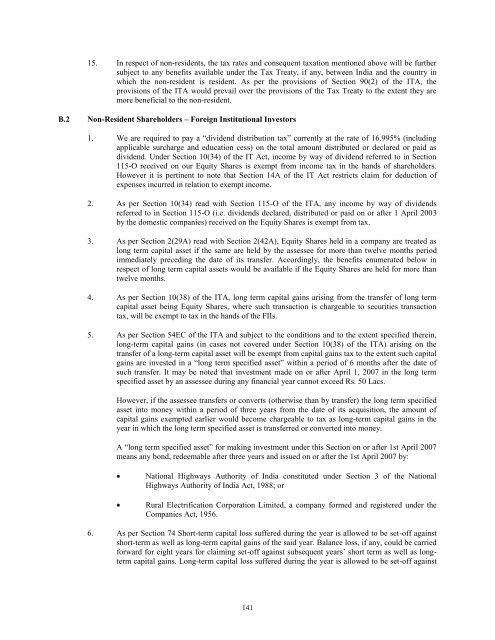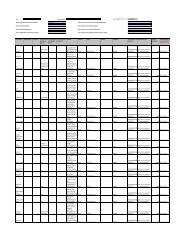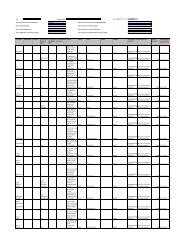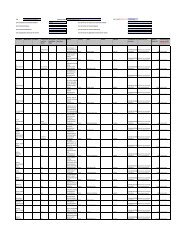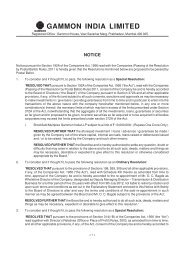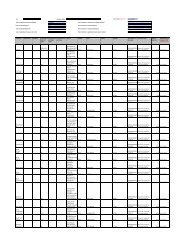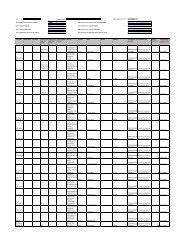GAMMON INDIA LIMITED
GAMMON INDIA LIMITED
GAMMON INDIA LIMITED
You also want an ePaper? Increase the reach of your titles
YUMPU automatically turns print PDFs into web optimized ePapers that Google loves.
15. In respect of non-residents, the tax rates and consequent taxation mentioned above will be further<br />
subject to any benefits available under the Tax Treaty, if any, between India and the country in<br />
which the non-resident is resident. As per the provisions of Section 90(2) of the ITA, the<br />
provisions of the ITA would prevail over the provisions of the Tax Treaty to the extent they are<br />
more beneficial to the non-resident.<br />
B.2 Non-Resident Shareholders – Foreign Institutional Investors<br />
1. We are required to pay a ―dividend distribution tax‖ currently at the rate of 16.995% (including<br />
applicable surcharge and education cess) on the total amount distributed or declared or paid as<br />
dividend. Under Section 10(34) of the IT Act, income by way of dividend referred to in Section<br />
115-O received on our Equity Shares is exempt from income tax in the hands of shareholders.<br />
However it is pertinent to note that Section 14A of the IT Act restricts claim for deduction of<br />
expenses incurred in relation to exempt income.<br />
2. As per Section 10(34) read with Section 115-O of the ITA, any income by way of dividends<br />
referred to in Section 115-O (i.e. dividends declared, distributed or paid on or after 1 April 2003<br />
by the domestic companies) received on the Equity Shares is exempt from tax.<br />
3. As per Section 2(29A) read with Section 2(42A), Equity Shares held in a company are treated as<br />
long term capital asset if the same are held by the assessee for more than twelve months period<br />
immediately preceding the date of its transfer. Accordingly, the benefits enumerated below in<br />
respect of long term capital assets would be available if the Equity Shares are held for more than<br />
twelve months.<br />
4. As per Section 10(38) of the ITA, long term capital gains arising from the transfer of long term<br />
capital asset being Equity Shares, where such transaction is chargeable to securities transaction<br />
tax, will be exempt to tax in the hands of the FIIs.<br />
5. As per Section 54EC of the ITA and subject to the conditions and to the extent specified therein,<br />
long-term capital gains (in cases not covered under Section 10(38) of the ITA) arising on the<br />
transfer of a long-term capital asset will be exempt from capital gains tax to the extent such capital<br />
gains are invested in a ―long term specified asset‖ within a period of 6 months after the date of<br />
such transfer. It may be noted that investment made on or after April 1, 2007 in the long term<br />
specified asset by an assessee during any financial year cannot exceed Rs. 50 Lacs.<br />
However, if the assessee transfers or converts (otherwise than by transfer) the long term specified<br />
asset into money within a period of three years from the date of its acquisition, the amount of<br />
capital gains exempted earlier would become chargeable to tax as long-term capital gains in the<br />
year in which the long term specified asset is transferred or converted into money.<br />
A ―long term specified asset‖ for making investment under this Section on or after 1st April 2007<br />
means any bond, redeemable after three years and issued on or after the 1st April 2007 by:<br />
National Highways Authority of India constituted under Section 3 of the National<br />
Highways Authority of India Act, 1988; or<br />
Rural Electrification Corporation Limited, a company formed and registered under the<br />
Companies Act, 1956.<br />
6. As per Section 74 Short-term capital loss suffered during the year is allowed to be set-off against<br />
short-term as well as long-term capital gains of the said year. Balance loss, if any, could be carried<br />
forward for eight years for claiming set-off against subsequent years‘ short term as well as longterm<br />
capital gains. Long-term capital loss suffered during the year is allowed to be set-off against<br />
141


